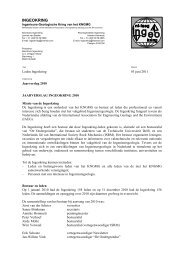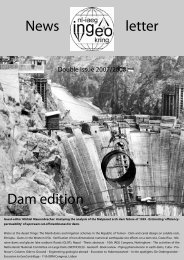environment
environment
environment
- No tags were found...
You also want an ePaper? Increase the reach of your titles
YUMPU automatically turns print PDFs into web optimized ePapers that Google loves.
Ingeokring Newsletter<br />
started in March 2003, which brings all relevant actors<br />
together. The eight components of the project cover<br />
the following areas:<br />
1. Rural Access Project (RAP) implementation support<br />
(World Bank credit);<br />
2. EFRC concept further development within the RAP;<br />
3. EFRC adoption by Department of Roads;<br />
4. Sustainable EFRC policy development;<br />
5. Introduction EFRC concept to other Road Agencies<br />
(mainly farm and forest roads);<br />
6. Capacity building for Districts and communities;<br />
7. Capacity building Private Construction Sector<br />
(mainly contractors and branch organisations);<br />
8. Dissemination of EFRC to Technical Training and<br />
Education Institutes.<br />
The EFRC Support Project will end in December 2005.<br />
Already at this moment there is a high demand for the<br />
(continued) services of SNV in the road sector, from as<br />
well RGoB as the international donor community,<br />
especially on district capacity strengthening for<br />
infrastructure development (EFRC) and for integrated<br />
rural accessibility planning combined with rural<br />
enterprise development and marketing support.<br />
SNV Netherlands Development Organisation<br />
SNV is a provider of advisory services to local<br />
organisations in developing countries and also supports<br />
knowledge development and dissemination. Through<br />
these activities SNV aims to contribute to reduction of<br />
poverty, increased equity and improved governance.<br />
SNV works from a broader understanding of poverty<br />
issues and patterns since specific poverty issues are<br />
often embedded in wider patterns of imbalances in<br />
power, in the right to claim support and in access to<br />
(economic) opportunities, on the basis of gender,<br />
cultural and/or socio-economic status.<br />
SNV provides services for diagnosis, organisational<br />
development, partnership building and institutional<br />
change. SNV provides these services mainly in the<br />
thematic areas of natural resource management, private<br />
sector development and local governance. To<br />
effectively assist its clients, SNV provides for a mix of<br />
technical-thematic and change expertise.<br />
The support from SNV Bhutan in the EFRC Support<br />
Project is focused on strengthening the organisational<br />
and institutional capabilities of the Department of Roads<br />
and other actors involved in road construction. SNV<br />
provides a variety of technical assistance which includes<br />
expertise for surveying, design, supervision and<br />
execution of the road construction projects. The present<br />
Technical Assistance team comprises of two<br />
international road engineering experts, five national road<br />
engineers, one <strong>environment</strong>al specialist, one<br />
construction development specialist and one<br />
community maintenance specialist. There is also a<br />
variety of short term national and international experts<br />
available in the areas of quality assurance, bioengineering,<br />
engineering geology, curriculum<br />
development, equipment management, transport<br />
economy, community organisation development and<br />
construction sector development.<br />
The main objective of SNV's technical assistance is to<br />
ensure that in future all road construction in Bhutan<br />
can be <strong>environment</strong>al friendly. The aim of the<br />
cooperation between all the partners is ultimately to<br />
create a self-sustaining Bhutanese capacity for<br />
<strong>environment</strong>al friendly road construction.<br />
Environmental friendly roads<br />
For the introduction of EFRC the normal project cycle<br />
for building the roads was analysed and adapted to<br />
include <strong>environment</strong>al friendly features. First, it was<br />
important to develop a realistic implementation plan for<br />
the road project, as well as a proper monitoring and<br />
evaluation system. A main focus at the start of the project<br />
was also to develop an Environmental Code of Practice,<br />
which provides <strong>environment</strong>al guidelines for all the<br />
stages of the road project cycles.<br />
Environmental friendly design takes into account<br />
specific site conditions such as wet areas, rocks, paddy<br />
fields and areas with high <strong>environment</strong>al and cultural<br />
value, to prevent and mitigate as much as possible<br />
<strong>environment</strong>al damage. Before the first excavator<br />
appears, these and other important site conditions are<br />
identified with a "desk study" of possible road<br />
alignments made by the design engineer in consultation<br />
with other team members. The desk study uses accurate<br />
maps based on aerial photographs and identified<br />
geologically-hazardous and culturally-vulnerable areas<br />
to plot out potential alignments between the villages to<br />
be connected.<br />
After the desk study is completed, a feasibility study<br />
and <strong>environment</strong>al impact and social assessments are<br />
made. The proposed road alignments must be verified<br />
in the field from an economic, technical, social and<br />
<strong>environment</strong>al point of view. For this purpose the<br />
Department of Roads survey team cooperates with the<br />
Environmental Assessment team and when found<br />
necessary with a team of the Department of Mines and<br />
Geology to find the best possible alignment. The National<br />
Environmental Commission Secretariat then reviews the<br />
EIA report for issuing the <strong>environment</strong>al clearance. It is<br />
only after this process has been completed that the<br />
actual work plan for the building phase begins.<br />
In order to make an optimal <strong>environment</strong>al friendly<br />
design, detailed survey data must be collected about<br />
26




